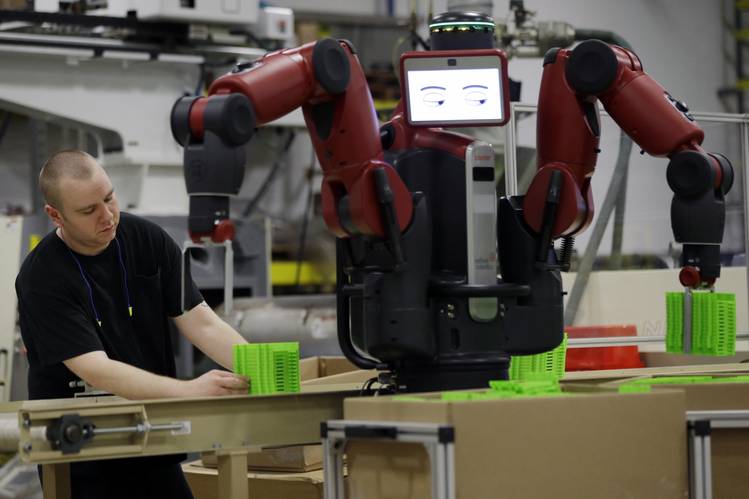By Willie Baptist and Kristin Colangelo
Today, the world is undergoing an unprecedented technological change from the industrial age to the information age. This transformation has given the capitalist economy its globalized character, while at the same time turning it against itself in chronic and systemic crises. In his 1998 essay “Rethinking Globalization”, researcher and analyst Jim Davis gives a brief synopsis of some of the major technical and historical aspects of this new epochal boomerang:
“The development of the microprocessor was the culmination of a long line of advances in everything from philosophy to electronics. The selection of the microprocessor as a pivot point is not entirely arbitrary, because it’s cheapness, lightness and versatility has made possible practical robotics, and has made possible breakthroughs in other fields by cheapening and extending the tools of scientific production. It, like other critical breakthroughs in biology, materials science, computing, and electronics, is a product of a widening understanding of the workings of the universe.
The microprocessor has had a particularly radical impact at the heart of the production process. The widening understanding of nature has given us the ability to record workers’ skills and encode it into tools, and to play back the skills in the absence, for all practical purposes, of workers. The microprocessor is the device that activates the production process, and brings to life, as it were, dead labor — the knowledge and skills of past workers… has been encoded into the instruments of production…
“These are technologies to squeeze the human being out of the labor process, not just in material production, but in mental production, and not just in the ‘advanced’ economies, but globally.”
Today, the capitalist economic system has given rise to the microelectronic revolution. Known also as the “information revolution,” the “digital revolution,” the “high-tech” or “technetronic” era, this is the most productive and comprehensive technological revolution in human history. It has heightened the productivity of the present economic system to a level far surpassing the capability of all previous economic systems combined. Compared with the Neolithic or agricultural and Industrial revolutions, its transformation of civilization is the most rapid, most thoroughgoing and most global and far-reaching. In comparison, this revolution is already making the industrial revolutions of the nineteenth and twentieth centuries seem like “storms in a teacup.” The major economic, social and ideological consequences those revolutions had in human history are well documented. The consequences of this new technological revolution portend to be many times more profound and widespread.

Although still in its early stages, the microelectronic revolution, largely through computerization and robotization, is already transforming world production, circulation, transportation, communication and the scope and speed of mathematical calculations. These mathematical calculations include the whole new world of what is called “high-frequency trading,” in which computer programs buy and sell huge amounts of shares of corporate stocks at breakneck speeds that are impossible for any human being to calculate. For instance, counting to 1 million at one number per second would take a person 12 ½ days; counting to 1 trillion would take 36,000 years. Movements of capital investments take place in magnitudes of milliseconds and can turn a tiny dividend into billions of dollars in profits. This new management of the movement of monies and commodities on a global scale is made possible only by this new information technology.
It is important in this context to take note of how the term “globalization” is often confused and misused. Today’s globalization of the world economy cannot be limited to the continuing internationalization of trade in goods and services that started in early stages of the modern capitalist economy. As pointed out, this qualitatively new technological revolution has also given rise to a general transnationalization of trade in capital in the forms of new branches of multinational corporations, cross border investments in stocks and bonds and in the titanic growth of world speculation. As early as 2002, the documentary Commanding Heights: The Battle for the World Economy, pointed out that “the Global Market” consisting of “trade in goods and services” amounted to $8 trillion”, while “trade in currencies (stocks, bonds, and currencies)” amounted to “$288 trillion.” Those numbers have exploded today.
In earlier eras, the steam engine and electro-mechanic industrial technological revolutions were labor-saving. Today, the new computer and robotic technology revolution has brought about a historic transition to labor-eliminating machinery. Labor-saving technology moved a large number of workers from one sector of the economy to another, and from production to services. Today, labor-eliminating devices are decreasing the need for human labor, manual and mental, in every sector from robotized auto production to huge computerized agricultural combines, from ATM machines and online banking to peopleless toll booths and new advances in 3D printing and artificial intelligence technologies, and more. This has created a new situation in which the recoveries from reoccurring economic crises of capitalism have been characterized as “jobless recoveries.”

Poverty wage jobs mean low and inadequate wages. No jobs mean no wages at all. Microelectronic technology employed for maximum profits is creating on one hand a huge worldwide producing capacity, while on the other hand rapidly decreasing purchasing capacity. Profits can only be realized through the buying and selling of commodities produced. Decreasing sales means decreasing rates of profits, which mean the highly competitive centralization of profits and wealth to ever-fewer individual big capitalists.
Together, all this has meant a general decrease in purchasing power for the average person. This market contraction has caused a dramatic and overextended expansion of personal, commercial and governmental debts to compensate for the capitalist system’s destruction of buyers and sellers. This is resulting in unsolvable economic crises finding expressions in persistent banking and financial crises.
In short, within the present economic system the labor-eliminating technological revolution is resulting worldwide in growing poverty amid unprecedented plenty, abandonment alongside unheard of abundance. It is creating both unprecedented global productivity capabilities and a systemic stagnation and constriction of the world’s purchasing capacity. This is an historic departure from all previous eras of production and technological development. That is to say, today’s technological revolution is bringing about a new revolutionary period of profound social transformation. This is a period in which the present capitalist economic system is objectively reaching the limits of its existence, beyond which a new system is not only possible, but necessary.
The new productive and communication capabilities of this era represent tremendous human achievements that have made possible the pursuit of even greater human wellbeing. For instance, a level of productivity has been reached in which less time is needed for manual labor, making it possible for more time to be directed toward creative and higher mental growth and happier cultural pursuits. Humankind has now reached a production capability where we can have a realizable vision of a society in which “all God’s children” have the right to not be poor, homeless, hungry and discriminated against because of race, gender and more.
The current block to that type of society is the globalized capitalistic economic system, protected in large part by the U.S. state. Under this current exploitative and competitive economic system, the productivity of the new technological revolution, its computerization and robotization of the economy, is rendering increasing segments of people jobless and superfluous, with no future for them and their children. Abolishing this huge economic and political block presents a big problem, which requires a big solution. History teaches that such problems and solutions necessitate social movements that are revolutionary in character. Today, because of the dramatic transformations in the economy, this revolutionary character is possible at a quality, depth, and global scope that is historically unprecedented. We are indeed in a new era of systemic, chronic and revolutionary crises in the present capitalistic order of society.

Just as the social and political consequences of the cotton-picking machine helped to produce the Civil Rights Movement, the older Welfare Rights Movement, and the Ghetto Uprisings of the 1960’s, the social and political consequences of the electronic microchip are producing a new welfare rights and anti-poverty human rights movement of the 21st century. Objectively, the welfare recipients, the homeless and the immigrant poor are no longer alone in their battle for the basic necessities of life. Over 140 million in the U.S. today live in or near poverty with no relief in sight.
The potential for a new and longer-lasting “morality of the poor” based on common interests now exists among the growing impoverished millions. It is now possible for this movement of millions to be built on the basis of a new morality of the class of the poor and dispossessed that can provide a broader and deeper base for mutual-class support and solidarity. The new strategy and leadership necessary for a social and political movement to abolish poverty must continuously study and take into account these basic historically evolved and economically conditioned factors of the new situation we face today.


Thank you for this amazing analysis.